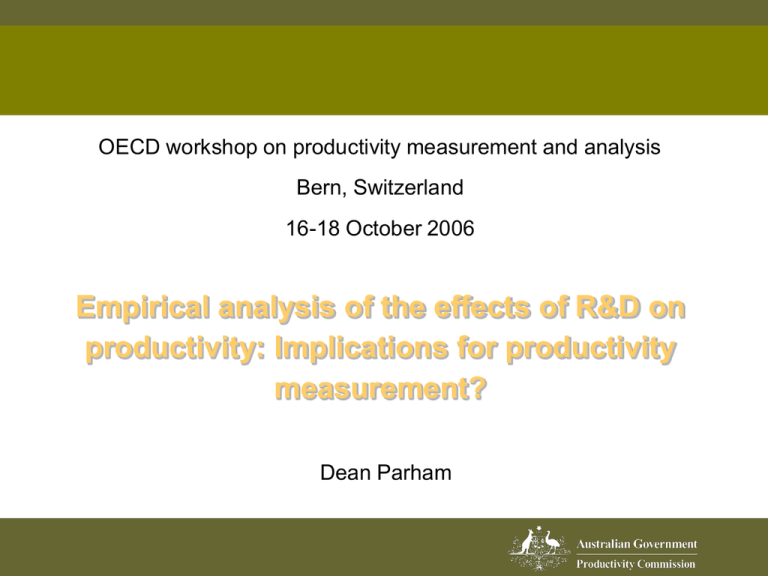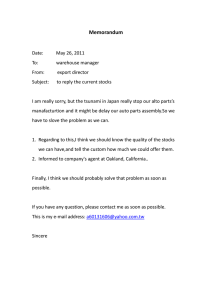Empirical analysis of the effects of R&D on measurement?
advertisement

OECD workshop on productivity measurement and analysis Bern, Switzerland 16-18 October 2006 Empirical analysis of the effects of R&D on productivity: Implications for productivity measurement? Dean Parham Motivation Empirical uncertainty about magnitude of R&D’s effect on productivity Shanks & Zheng (2006), Econometric Modelling of R&D and Australia’s Productivity, Productivity Commission Staff Working Paper Not just this study. Widespread through other studies/countries Certainty about magnitude of effects will be implicit in national accounts if proposals to capitalise R&D are implemented Canberra II group recommendations R&D capital would be incorporated into productivity estimates Is there a problem here? 2 Outline Formation of R&D capital stocks The Shanks & Zheng study Why the empirical uncertainty? Capitalisation of R&D in the national accounts Concluding remarks 3 1. Formation of R&D capital stocks R&D outputs are largely unobservable Knowledge assets measured by use of R&D inputs Implicit assumption of constant relationship between R&D inputs and R&D outputs ie constant productivity of R&D Accumulated via the perpetual inventory method (PIM) K Rt 1 (1 )K Rt R t 4 Business R&D capital stocks: levels Index 120 15 per cent 5 per cent 100 10 per cent 80 60 40 20 0 1968 1976 1984 1992 2000 5 Business R&D capital stocks: annual growth 15% 15 per cent 5 per cent 10% 10 per cent 5% 0% -5% 1968 1976 1984 1992 2000 6 Domestic and foreign business R&D stocks 120 15% 100 Australia 10% 80 60 5% Foreign 40 Foreign Australia 0% 20 0 -5% 1968 1976 1984 1992 2000 1968 1976 1984 1992 2000 7 Characteristics Generally smooth Timing and extent of growth in domestic v. foreign stocks R&D tax concession Change in structure of R&D business shift to services firm entry 8 2. The Shanks & Zheng study Conventional framework Cobb-Douglas specification ni lnY lnA llnK o 2lnK R lnL t WlnZ i i i 1 ‘Two step’ transformation 9 Estimation of standard models Models with limited controls mis-specified Models with extended controls OK returns to R&D point estimates of 60%, but imprecise (include zero) negative coefficient on either domestic or foreign stock commonly found other explanators more robust human capital, ERAs, communications infrastructure, ICT, decentralised wage bargaining Dynamics and lags little improvement Sensitivity testing on PIM depreciation rate Variation in implied returns, but no improvement in precision 10 Further exploration Specification in growth form elements of endogenous growth continuation of mixed results Two equation specification separate specifications for determinants of domestic R&D and for determinants of productivity showed more promise indications that foreign R&D had positive effect via domestic R&D as well as directly 11 Summary Effect of R&D on productivity hard to pin down Mis-specification in standard models Imprecise estimates Sensitive to reasonable changes in model and variable specification Some reasonable models and robust explanation from other factors 12 3. Why the empirical uncertainty? Generic limited degrees of freedom multi-collinearity measurement problems Country and period specific shocks to R&D and to productivity policy changes and ‘phantom’ effects of the R&D tax concession 13 Measurement: Use of constructed variable to proxy R&D knowledge asset Smoothness of change. Contributed by two principal assumptions Constant productivity of R&D across projects single price deflator on R&D inputs subsumes differences in value of R&D outputs across time same real input use generates same increment to stock in all periods. Constant (or at least steady change in) depreciation rates 14 Criticisms R&D outputs highly heterogeneous. Not same price/value Productivity of R&D affected inter-temporally by: technological opportunities organisation of R&D policy changes in Australia Depreciation of knowledge diversity in depreciation rates changes in R&D composition affect average depreciation interactions lead to increasing returns and discontinuities 15 4. Capitalisation of R&D in the national accounts Same essentials use of the PIM Open to similar criticisms concerns about accuracy of measurement of R&D-based knowledge stocks Flow-on effects R&D capital enters capital input measure in derivation of productivity estimates deterministic effect on productivity smooth effect on productivity growth smooth change in R&D stocks small effect? relative size of R&D capital and conventional productive capital stock, relatively high rental price weight 16 Criticisms Doubtful accuracy ‘Conservative’ but not accurate R&D not the only form of knowledge accumulation Different views on how knowledge relates to productivity not just like a physical asset 17 Doesn’t look good, but …. Problems in current procedures R&D expensed underestimate value added particular relationship between R&D and productivity is imposed by default Choose between the ‘lesser of two evils’ current: incorrect MFP, errors related to size of current R&D expenditure and to its expensing in the accounts proposed: inaccurate but ‘smoothed’ effect on MFP, errors related to mismeasurement of knowledge and rental prices and to limitations of specification of relationship between knowledge and productivity 18 5. Concluding remarks Capitalisation may be lesser of the two evils But that does not make it right Transparency to assist users limitations assumptions choice? Communication to improve broader understanding 19


